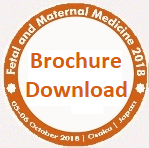
Adriano Carneiro da Costa
Federal University of Pernambuco, Brazil Sessions: Women Reproductive Health | Maternal-Fetal Medicine | Anesthesia for Fetal
Title: Prognostic value of factors associated with hypoxia and lipid metabolism in patients with colorectal cancer
Biography
Biography: Adriano Carneiro da Costa
Abstract
Background: Colorectal Cancer (CRC) is a neoplasia with high incidence and mortality rates. It had been suggested that the inflammatory response is an important CRC prognostic factor. The disordered and accelerated proliferation of neoplastic cells decreases the oxygen and nutrient supply, generating a microenvironment characterized by hypoxia, necrosis and inflammation.
Aim: This study aimed to evaluate the impact of factors associated with hypoxia, such as HIF1A (Hypoxia-Inducible Factor 1-Alpha) and VEGF (Vascular Endothelial Growth Factor) and with lipid metabolism, including PPARG (Peroxisome Proliferator-Activated Receptor-Gamma), LXRA (Liver X Receptor-Alpha) and LXRB (Liver X Receptor-Beta), on the Overall Survival (OS) of CRC patients.
Methods: This was a cohort study of 101 patients with high-risk stage II-III (TNM) CRC located above the peritoneal reflection. They were treated between 1990 and 2004 at the A.C. Camargo Cancer Center. Immunohistochemical analyses of HIF1A, VEGF, PPARG, LXRA and LXRB protein expression were performed using Tissue Microarrays (TMAs).
Results: There was an association between the presence of vascular invasion and the lack of VEGF expression (p=0.028) as well as with positive HIF1A expression and lymphatic invasion (p=0.045). The 5-year and 10-year OS rates were 76.6% and 60.2%, respectively. Patients with PPARG-positive tumors had a higher OS (p=0.018). There were no correlations between the positive expression of VEGF, HIF1A, LXRA or LXRB and OS. The Cox regression model demonstrated that the risk of death was 2.72-fold higher in patients with PPARG-negative tumors (95% CI=1.08– 6.85).
Conclusion: The PPARG expression was an independent prognostic factor for CRC tumors and might be used for risk stratification to stage II and stage III CRC patients.

